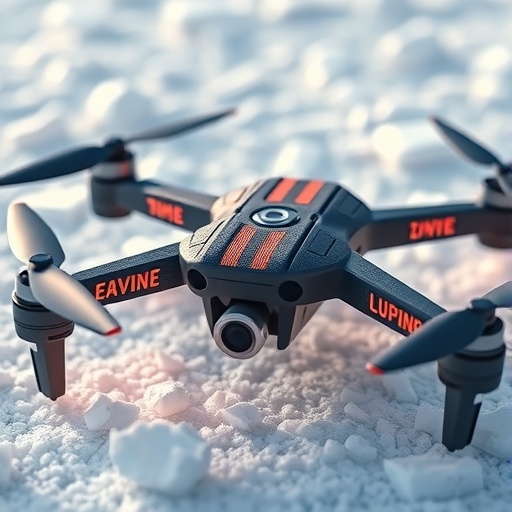
In the rapidly evolving landscape of aerospace and unmanned systems technology, researchers continuously seek innovative materials and designs to enhance the safety, efficiency, and longevity of unmanned aerial vehicles (UAVs). A groundbreaking development has emerged from a team led by Xu, Li, Tian, and colleagues, introducing a revolutionary “self-healing UAV skin” that not only prevents icing but also offers intelligent monitoring capabilities. This multifaceted advancement, published in npj Flexible Electronics, promises to address some of the most persistent challenges in unmanned flight, particularly in hostile environmental conditions where ice accumulation threatens flight stability and sensor integrity.
The problem of icing on aircraft surfaces is well-known, often compromising aerodynamics, increasing weight, and impairing sensor functionality. Traditional de-icing systems rely on mechanical or thermal methods, which add weight, increase energy consumption, and introduce points of potential failure. The novel approach adopted by this research team reimagines UAV skin as a multifunctional material capable of autonomous damage repair and real-time environmental adaptation, seamlessly integrating prevention, detection, and response mechanisms into the vehicle’s outer layer.
At the core of this innovation is a flexible, self-healing polymer composite that can restore its structural integrity upon damage, such as microcracks or abrasions that might appear during flight operations in rough weather or collision with debris. This polymer matrix incorporates microcapsules filled with a healing agent that, when triggered by mechanical rupture, promptly fills the crack and polymerizes to re-establish continuity. This mechanism extends the operational lifespan of UAVs by maintaining the aerodynamic surface and protecting embedded sensors without requiring manual maintenance or replacement.
.adsslot_OMBeR4tTlN{width:728px !important;height:90px !important;}
@media(max-width:1199px){ .adsslot_OMBeR4tTlN{width:468px !important;height:60px !important;}
}
@media(max-width:767px){ .adsslot_OMBeR4tTlN{width:320px !important;height:50px !important;}
}
ADVERTISEMENT
The icing prevention functionality is enabled through an embedded network of nanoscale heaters integrated within the polymer skin. Leveraging conductive nanomaterials such as graphene or carbon nanotubes, this network can precisely regulate temperature across the surface, preventing ice nucleation and accumulation even in sub-zero temperatures. The distributed nature of this heating element allows for energy-efficient operation, activating only in regions where icing is detected or likely to develop, thereby conserving the UAV’s power reserves for extended missions.
Alongside thermal control, the skin is embedded with an array of flexible sensors capable of continuously monitoring environmental variables such as temperature, humidity, pressure, and ice formation. These sensors are interconnected via a stretchable circuit architecture that maintains sensor connectivity even when the skin undergoes deformation. This self-contained monitoring system enhances situational awareness, providing the UAV with autonomous intelligence to adapt flight parameters or trigger protective measures in real time.
One of the most striking features of this UAV skin is its ability to integrate self-healing and environmental sensing seamlessly with an onboard diagnostic system. The composite material works in concert with machine learning algorithms running in the UAV’s control unit, which analyze sensor data to identify patterns of icing risk and structural stress. This predictive maintenance capability allows the UAV to anticipate failures before critical damage occurs, scheduling self-repair cycles and triggering heating elements preemptively to avoid ice formation altogether.
The fabrication process of this advanced skin combines state-of-the-art techniques in flexible electronics with novel material chemistry. The base polymer matrix is synthesized through a combination of thermoplastic elastomers and healable cross-linking agents, optimized for elasticity and mechanical robustness. Embedded conductive paths are patterned using inkjet printing of conductive inks, with nanoscale materials dispersed uniformly to ensure consistent electrical properties. This scalable manufacturing approach points to the feasibility of commercial deployment without prohibitive costs.
In laboratory testing, the self-healing UAV skin demonstrated remarkable resilience to mechanical damage, with full recovery of tensile strength within minutes after scratching or puncture under environmental conditions simulating operational flight. The icing prevention system maintained surface temperatures above freezing despite exposure to simulated atmospheric supercooled water droplets, effectively preventing ice accumulation across varied wind speeds and humidity levels. Sensor arrays maintained functionality and accurate readings throughout these tests, affirming the skin’s multi-modal capacity.
Furthermore, field trials aboard prototype UAV platforms showed that the smart skin could detect the onset of ice formation and autonomously activate heating zones, restoring safe flight conditions without any pilot intervention. These trials validated the skin’s ability to maintain aerodynamic stability and sensor integrity even during rapid temperature changes and turbulent weather, a critical step forward for UAV operations in high-risk environments such as mountainous regions, offshore platforms, and polar areas.
The integration of intelligence into the skin material itself represents a transformative step beyond traditional aerostructures, which rely heavily on separate, often bulky and heavy, de-icing and monitoring systems. By embedding multifunctionality at the material level, the design not only reduces overall UAV weight but also enhances stealth and energy efficiency—factors increasingly vital in military, commercial, and scientific applications.
Moreover, the self-healing mechanism extends the concept of material lifespan well beyond conventional limits, reducing maintenance cycles and operational downtime. This longevity attribute is especially pertinent for UAVs that operate in remote or inaccessible locations, where frequent maintenance visits are impractical or cost-prohibitive. The skin’s ability to self-repair minor abrasions or cracks mitigates cascading failures that could compromise mission success.
The researchers also highlight the potential for integrating additional functionalities into this platform, such as adaptive camouflage, energy harvesting modules, or enhanced electromagnetic shielding against jamming and interference. The modularity of the design approach allows for customization tailored to specific mission requirements, paving the way for a new generation of smart, resilient, and versatile UAV platforms.
Looking ahead, challenges remain in scaling production to meet industrial demands and in further improving the skin’s response time and energy consumption characteristics. The team is exploring advanced machine learning models to better predict icing patterns based on environmental data streams, and investigating alternative healable chemistries that could operate under an even wider range of temperatures and stress conditions without compromising flexibility.
In an era where UAV applications are growing exponentially—from delivery drones and environmental monitoring to defense and disaster response—the advent of self-healing, icing-resistant, intelligent skins marks a pivotal innovation. This research not only solves a pressing mechanical and environmental problem but also advances the conceptual framework of what an aerial vehicle’s skin can be: a dynamic, interactive interface between machine and environment, capable of autonomous adaptation, protection, and regeneration.
This pioneering work by Xu, Li, Tian et al. undoubtedly sets a new benchmark in UAV material science and flexible electronics, heralding a future where unmanned systems are safer, smarter, and more durable than ever before. As these technologies mature, the implications will ripple across industries, redefining operational capabilities and sparking new possibilities for aerial robotics.
Subject of Research: Development of self-healing, multifunctional UAV skin materials for icing prevention and intelligent environmental monitoring.
Article Title: Self-healing unmanned aerial vehicle skin for icing prevention and intelligent monitoring.
Article References:
Xu, S., Li, R., Tian, S. et al. Self-healing unmanned aerial vehicle skin for icing prevention and intelligent monitoring. npj Flex Electron 9, 61 (2025). https://doi.org/10.1038/s41528-025-00434-3
Image Credits: AI Generated
Tags: aerospace engineering advancementsautonomous damage repair mechanismschallenges of icing on aircraftenhancing UAV safety and efficiencyenvironmental adaptation in UAVsflexible polymer composites in aerospaceice prevention in unmanned aerial vehiclesintelligent monitoring capabilities for dronesmultifunctional materials for dronesreal-time monitoring systems for dronesself-healing drone technologyUAV skin innovations



